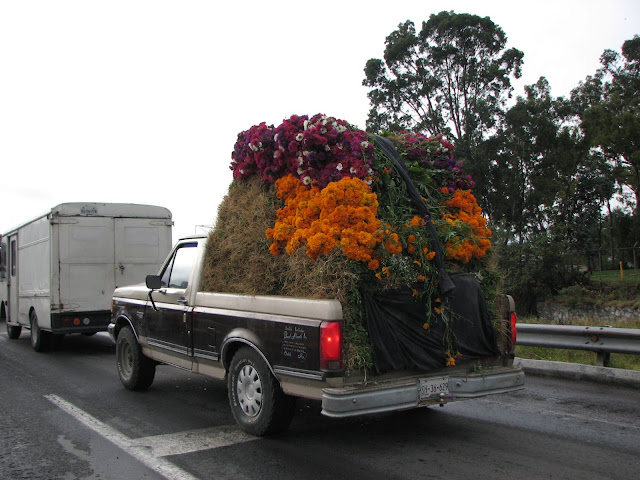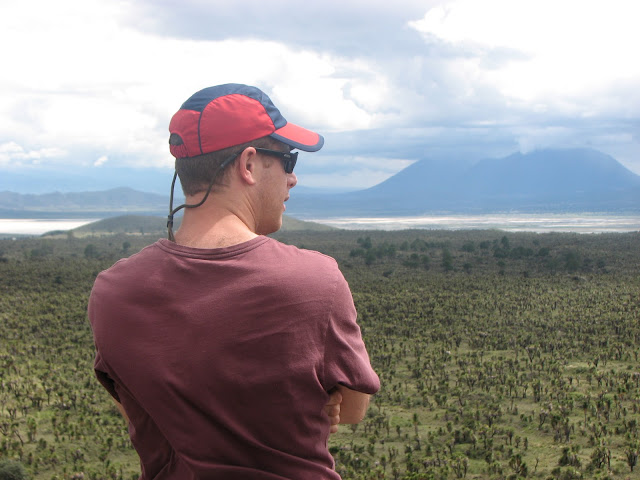
An excerpt from Wonder Travels: a memoir
by Josh Barkan
...Because he’s been everywhere, Joaquin suggests one day Monica and I should drive to the coast of the state of Oaxaca. It’s a two-day drive to go only a hundred and forty miles, but the trip he and Marta describe sounds so appealing we change our plans and head out the next day for the coast.
There are two sections to the journey, Joaquin tells us—the part of speed bumps and the part of curves. The speed bumps crop up every half-mile on the open road and much more frequently in the small towns. They slow the journey considerably. But in a weird way, despite the frustration of having to come to a rolling stop so often we’re nearly seasick, they force us to take in the small details of the people and places around us. Most of the time you can’t go fast in Mexico, so you see passengers hanging out the back of a truck as they slowly move up a mountain. You see kids playing soccer with improvised soccer balls—made of rags or coconuts. You see auto repair shops with old beat up cars and food stalls with fresh tamales and tacos. The air is dusty in Oaxaca. There’s a severe drought and the corn is dying in the fields, but the patchwork of hand-planted corn, with stalks slanting to and fro in the wind stretching into the distance until they fade into a dusty blue up the side of the mountains, gives a sense of freedom the earth is unlimited, untamed, still raw. These are ancient valleys, with farmers who’ve been planting corn for thousands of years. They fit into the landscape, not apart from it. Once in a while where there’s construction going on we’re pulled off the pavement onto a long stretch of dirt and rocks. Signs are unclear. It’s easy to get lost. Sometimes we get sidetracked in these places, following other cars, and we have to turn back. The section of speed bumps makes way for the section of curves, when we reach the end of the big valleys and begin to climb the high sierras between our van and the ocean. The road climbs around the face of these high mountains, a primitive narrow two-lane path with no rock-blastings through the mountains. We ride like ants on the surface of an anthill. The plants turn from dusty desert cover to green mountain ponderosa pines and a profusion of yellow flowers and pink orchids that fall down the high slopes of the mountains, bending with the weight of mountain gravity, slanting toward the valleys below. The locals live perched by the side of the road. There’s so little space they build on the shoulder beds with stilts out over the side of the mountain. They live poor, with almost no room to cultivate any food. Where they can, they plant corn on steep mountain slopes using seed passed down for hundreds of years. Genetically modified corn is still rare in this area, and the corn comes in purples and vibrant oranges, the kernels fat and uneven. The few inhabitants along the road cut wood in the forest to heat their homes. They sell flowers to travelers and plant flowers in pots around their houses to keep them beautiful. I see this beauty throughout Mexico. The poorest people are the ones, often, with the most taste and the strongest desire to make their homes beautiful. Against all odds, with no money for luxuries, they paint their homes bright festive yellows, oranges and green. They braid their hair and put on clothes sewn by hand with embroidery. It’s not a happy “native” life. It’s tough. But they make the best of it . . .
Over the next sixty miles we descended more than ten thousand vertical feet, running to the sea, curving left and right, back and forth so many times I calculated there must be close to a thousand curves, and Monica became dizzy and a bit car sick. I tried to make her more comfortable. Where I could, I smoothed out the curves by driving in the oncoming lane. We were alone most of the time, caught in mountains with flowers and a thickening jungle as we neared the ocean. Sometimes a truck would block us, and it was impossible to pass for miles—there were so many blind curves. Sometimes thick mist cut off most visibility. The plants became more and more exotic, turning into big ceiba trees covered with vines. We saw a tarantula jump on the road as a car went by. The mountains were too steep and the earth too poor for anyone to farm. Here and there the only sign of people were food stalls with hanging bananas.
We were tired as we approached the coast, from all the driving, but when we finally turned off to a side road where we could see the first sand filling in potholes on the road, and drier plants in bloom with white flowers, the smell of the ocean crept over a hill, and then we went down and around a bend and the Pacific lay before us deep blue, reaching from cliffs on the right to the far end of the open bay, a feeling the ocean went to infinity to the other end of the world in front of us...
Josh Barkan's books include Before Hiroshima: The Confession of Murayama Kazuo and Other Stories; Blind Speed: a novel and Mexico: stories (Hogarth/Penguin Random House). Mexico was selected as one of the five best story collections of 2017 by Library Journal. His memoir Wonder Travels will be published in 2023.


No comments:
Post a Comment
Note: Only a member of this blog may post a comment.